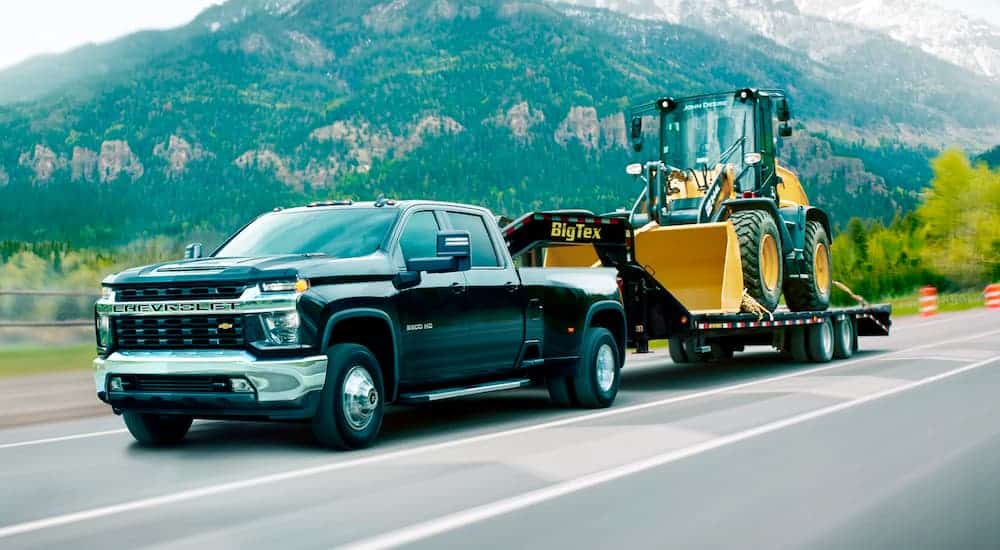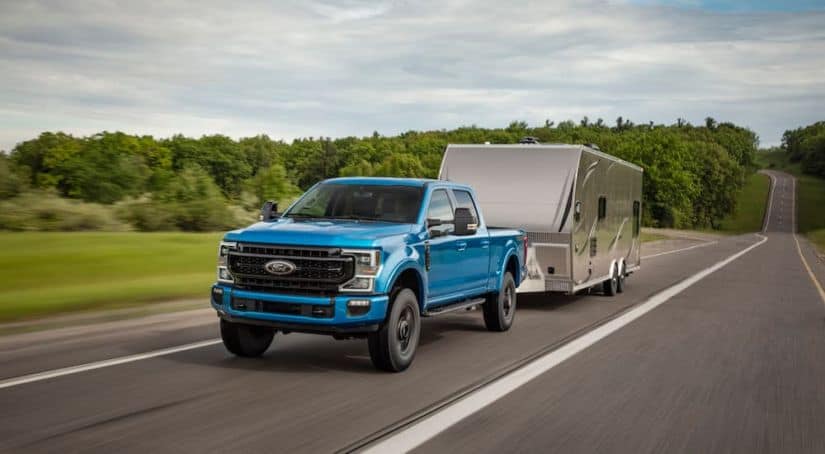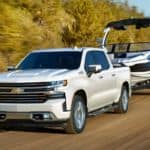If you’re interested in a truck for towing, then there are many things to consider before making a purchase. Knowing exactly what kind of towing you want to do and how much weight you need to pull is essential to ensuring you get the right type of truck to handle your needs. Simply glancing at a manufacturer’s website or a truck brochure, you might see a maximum capacity of 20,000 lbs and assume it can pull that much weight behind it no matter what. But, in reality, there are specific conditions for it to reach that capacity, and at other times it can max out at much less weight.
Today, I’m going to take you through the different types of towing you can do with a pickup, how each one is different, and why you might choose one over another. Then, I’ll talk about the different types of trucks and which one is best for the towing purposes you might need to handle. In the end, I’m not going to tell you which model to choose – there’s a lot more to consider for that than just towing. But, you’ll have a good sense of the type of truck to look for, and that will narrow down your options significantly.

Frame-Mounted Hitches
First up, I’m going to take you through the different types of towing available because you need to have a grasp of this before looking at types of trucks. For a lot of people, frame-mounted hitches are all that you’ll use. These are your typical hitches mounted to the rear of your vehicle that stick out the back. Common types of frame-mounted hitches include:
- Fixed Ball Mount – This is probably the most common type of towing hitch overall. It’s a rear hitch that inserts into a receiver on your truck, with a large ball joint sticking up from it. Your trailer will have a cup that fits over the ball. You’ll find them in a wide range of sizes and weight limits.
- Adjustable Ball Mount – This is similar in design to a fixed ball hitch, but there are different ball sizes available that you can easily switch out. If you have multiple trailers or a trailer and a camper with different hitch sizes, then this is ideal.
- Pintle Hook – Rather than a connection that looks like a ball and socket joint, a pintle hitch uses a round eyelet with a closing hook that latches onto it. This makes for a very secure connection while still allowing movement for the trailer when backing up or turning. These are often used for going off-road since they’re flexible, but they can also be quite loud.
- Weight-Distribution Hitch – These are similar to fixed and adjustable ball mounts, but they redistribute their weight better than those conventional hitches. They have improved handling and often come with sway control, making them great for use in windy conditions. This type of hitch is particularly good for towing a trailer near the weight limit of a truck.
Although exact weight limits will vary from one hitch to another, they’re usually rated to go from anywhere between 2,000 and 10,000 lbs. So a frame-mounted hitch is best if you’re looking to tow something in that weight range.
Bed-Mounted Hitches
If you need a lot more towing capacity, then a bed-mounted hitch is likely your best bet. Rather than sticking out the back of your vehicle, these are attached or installed into the bed of a truck, directly onto the frame over the rear axle. This connection allows them to handle more weight than a rear hitch can manage. Common types of bed-mounted hitches include:
- Fifth-Wheel – This type of hitch is often used for large campers and similar trailers. It installs into the bed of a truck, where a kingpin on the trailer slides down into the fifth-wheel hitch and is secured. Due to its size and weight, you lose a lot of space in the bed for storage, and it’s difficult to remove when you’re not using it.
- Gooseneck – This is essentially a ball hitch that sticks up out of the bed of the truck, which a trailer then connects to. Attachment points for a gooseneck can be built right into the frame of a truck, and it’s easy to remove if you need to use your bed for a large load. It’s not as stable as a fifth-wheel setup, so it’s not as good for long trips on the highway, but it’s great for rough conditions due to its flexibility.
Again, the weight limits on these hitches will vary, but if you’re looking to haul 10,000 to 30,000 lbs. behind your pickup, a bed-mounted hitch is typically the way to go.

Different Types of Trucks for Towing
So, now that we have a good sense of the different types of hitches that are available, what about the different types of trucks? In general, you’re looking at two different factors: the overall size of the truck and its class (in terms of weight). Both of these things have a big impact on the truck you should choose for the kind of towing you want to do.
First up, there are midsize and full-size trucks available. Midsize models are smaller, as the name suggests, giving you less space in the bed and cab – though they tend to still have roomy cabs. You can use a frame-mounted hitch on a midsize truck, but a bed-mounted option is typically out of the question. These will have the lowest maximum towing capacities overall, typically topping out in the 7,000 lbs range. Popular midsize trucks include the Toyota Tacoma, Chevy Colorado, Ford Ranger, Nissan Frontier, and Jeep Gladiator.
Full-size trucks are larger, with longer beds, more spacious cabins, and higher towing capacities. There are several different classes of full-size trucks that you’ll often hear: half-ton, three-quarter-ton, and one-ton pickups. These names used to refer to the kind of weight they could haul, but a modern half-ton can now handle over one and a half tons of payload. While they are all full-size trucks, half-ton trucks are considered “light-duty” vehicles, while three-quarter-ton and one-ton trucks are “heavy-duty” models.
Half-ton models are a good middle-ground between the midsize pickups and the much larger trucks out there. You can get up to 14,000 lbs of maximum towing with these models, but most half-tons average around 10,000 lbs. Common half-ton models include the Ford F-150, Ram 1500, Chevy Silverado 1500, Toyota Tundra, and Nissan Titan.
Three-quarter-ton trucks are significantly more powerful, with heavy-duty designs and engines that can handle some serious weight. They can usually tow up to about 17,000 to 20,000 lbs. when properly equipped. Examples include the Ford F-250, Ram 2500, and Chevy Silverado 2500.
One-ton or full-ton trucks are absolute beasts that are your best choice if you’re looking to do some bed-mounted towing. While they are generally the same size as three-quarter-ton trucks, they have beefed-up suspension and are usually available with a dual-rear-wheel configuration that is perfect for putting extra weight above the axle. With one of these trucks, you can get up to about 35,000 lbs of maximum towing with a bed-mounted hitch and the right setup. Common choices include the Ford F-350, Ram 3500, and Chevy Silverado 3500.
Choosing the Right Truck for Towing
As you can see, the right type of truck and the right type of towing hitch really comes down to how much weight you need to tow. So, when you’re shopping for a pickup, start by figuring out the weight of your trailer, camper, boat, or whatever else you’ll need to tow. Be generous with the maximum weight – you don’t want to underestimate – and then use that to guide you on the right type of truck for what you need.



